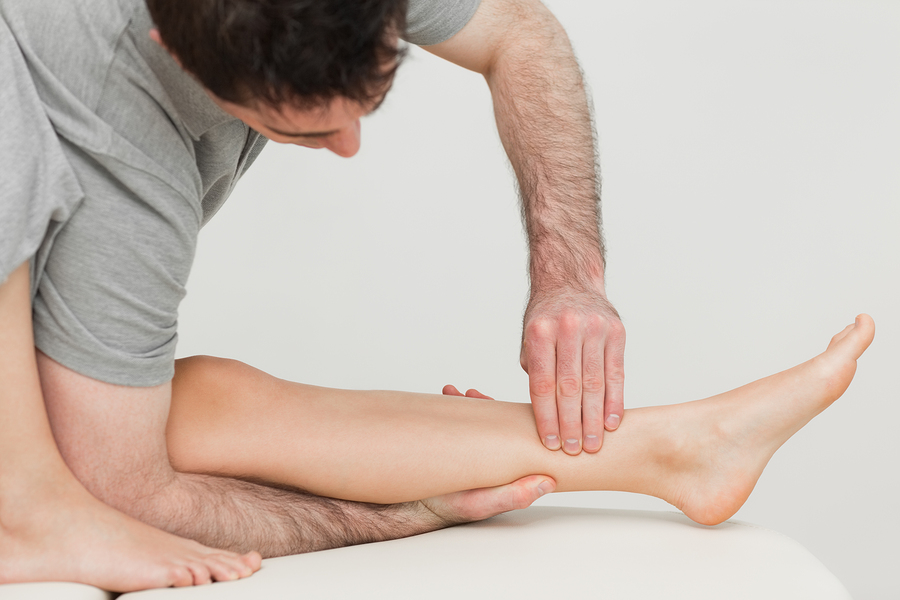Wednesday Q & A with Dr. JJ - My Shins Really Hurt When I Run, What Can I Do?

So, it feels like someone is sticking a knife in your shin when you get done with your run or if you have to move quickly to catch the toddler before he falls? You could have shin splints, or, worst case scenario, a stress fracture of one of the bones in your lower leg. I'll discuss stress fractures another day; today let's focus on shin splints. There are a couple of potential causes for shin splints, and neither of them has much to do with overuse. In my clinical experience when a person presents with shin splints it is usually an imbalance of the joints of the foot or the muscles of the lower leg; mainly the posterior tibialis muscle.
 There are two types of shin splints - anterior and posterior. The anterior type of shin splint usually involves the anterior tibialis muscle; this is the muscle that is on the front part of your tibia (shin). It is typically painful in running or downhill walking and can be very sharp, knife-like pain in that muscle.
There are two types of shin splints - anterior and posterior. The anterior type of shin splint usually involves the anterior tibialis muscle; this is the muscle that is on the front part of your tibia (shin). It is typically painful in running or downhill walking and can be very sharp, knife-like pain in that muscle.
The posterior type, involves the posterior tibialis muscle. It is typically denoted by pain in the deeper muscles behind the tibia. This type is more of a constant pain when walking standing or weight bearing.
The medical profession believes that these problems are mostly due to overuse and can be fixed by rest and ice. Those things will help, but they are just treating the symptoms and not fixing the overall cause of the dysfunction of these tibial muscles. Both forms of shin splints can be related to improper foot mechanics and poor foot striking when walking and running.
There are 26 bones in each foot, these bones make up about 25% of the bones in your body! So, with all of these joints if even one or two are out of place it can cause your tibial muscle to either not support, or have to work harder to support, the foot. If you are suffering from shin pain you really want to make sure that the joints of your feet are moving properly. This is where a properly trained Chiropractor with Applied Kinesiology come in very handy. They can test these muscles to see if they are stabilizing the joints properly and, if they're not stabilizing, decide what will facilitate and help the muscles respond properly.

This is where you find the pain for posterior shin splints. Patients may also want to look into changing their running style. If you are a heel striker when running you will likely find yourself more prone to shin splints. I tend to lean toward the barefoot running style, or at least the mid-foot striking for running. I've found, and have fixed, many people that thought they would never be able to run again because of the pain from shin splints.
Anterior splints can be related to hydration and type/amount of water patients are drinking. And, yes, you can drink too much water! Patients also need enough minerals and salts in their diet to help hold onto the water they are drinking.
Posterior shin splints are generally a result of patients eating way too much starch and sugar, which can inhibit the posterior tibialis muscle. These patients have to cut out all the starch, grains, and sugar from their diets and have to change the way they are training. These patients should do more low level cardio based exercise, and do a lot less High Intensity Training.
This shift of exercise routine will force the metabolism from sugar burning to predominantly using fat as its fuel. This will help balance the posterior tibial muscle and help the body use the anti-inflammatory fats as fuel. Suggestions to help with shin splints:
- Get your feet adjusted and properly taped.
- Drink water and salt your veggies and protein.
- Balance your diet by cutting out starches and sugars.
- Switch up your training for lower intensity style of training.
Hope this helps get you back on your feet and active! I hope you found this week’s Q & A helpful. Please pass it along and, if you have any questions, please send them to [email protected]
Stay connected with news and updates!
Join our mailing list to receive the latest news and updates from our team.
Don't worry, your information will not be shared.

